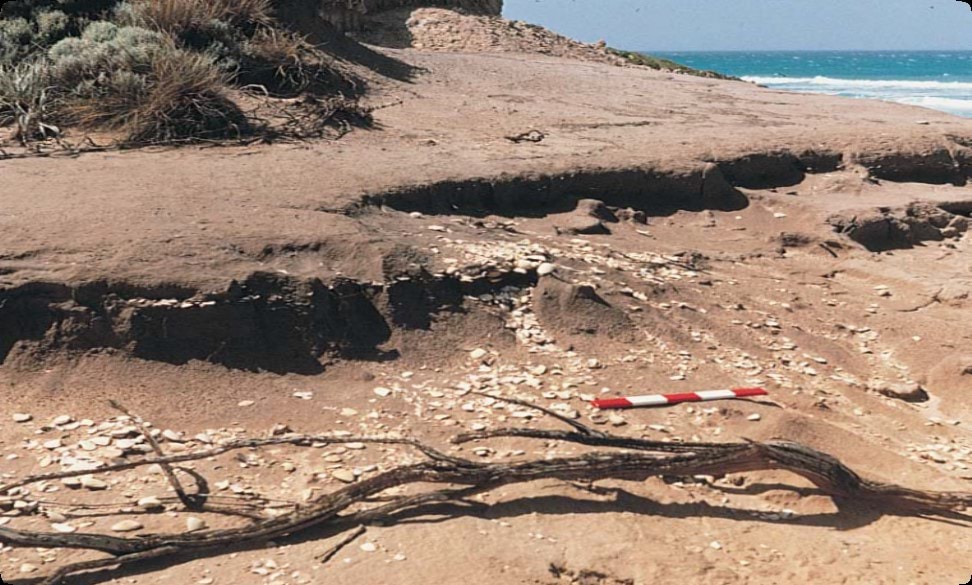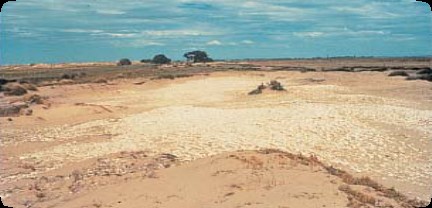Characteristics
- concentrations of marine or estuarine shells from a wide range of local species
- shells are generally large
- shells may be blackened from cooking fires
- usually associated with brown or black, ashy, charcoal-rich soils
- bones from native mammals and fish and crustacea shell can be present
- stone and bone artefacts, grinding stones and stone pounders can be present
- occasionally, Ancestral Remains will occur
- shellfish remains may include mussel, oyster, warrener, pipi, abalone, limpets, turbo and whelks

What are Aboriginal coastal shell middens?
Coastal shell middens contain the remains of shellfish eaten by Aboriginal people. They can consist of the shells from a single meal or many different meals eaten in the same location over many years.
They can also contain the remains of a more varied diet including fish, seal and kangaroo. Charcoal and hearth stones from fires as well as other cultural items such as stone and bone artefacts can also be present.
Where are coastal shell middens found?
Shell middens are found in many areas along the Victorian coast. They can be located in sheltered positions in the dunes, coastal scrub and woodlands, within rockshelters, or on exposed cliff tops with good vantage points. They can occur near rocky or sandy shores and also close to coastal wetlands, inlets, estuaries, bays and river mouths.
Coastal shell middens are found as layers of shell exposed in the sides of dunes, banks or cliff tops, or as scatters of shell exposed on eroded surfaces. They range in size from a few metres across to many hundreds of metres and can consist of a thin, single layer, or multiple layers forming a thick deposit.
What produced Aboriginal shell middens?
Shell middens are the remains of meals of shellfish once gathered and eaten by Aboriginal people.
Aboriginal people gathered a range of shellfish species. They were gathered from rock platforms and from the sandy shores of ocean beaches, river inlets, estuaries and bays.
On rock platforms, shellfish such as mussels were pulled off in sheets, while snail-like turbos and whelks were prised off with wedge shaped sticks, stone and bone tools, or fingers. Rock platform shellfish from the sub-tidal zone, such as abalone, were obtained by diving.
On sandy beaches, the shellfish were dug up with sticks, hands and feet. Aboriginal people collected the larger shellfish because they contained more meat.
Aboriginal people often took their catch back into sheltered areas behind the beach to cook and eat. Shellfish were also eaten raw, but the presence of burnt shell indicates they were just as frequently cooked in hot coals. Heat from fires opened bivalves slightly, whereas meat from whelks and turbo shells had to be prised out.
While many Aboriginal shell midden places are the sole result of shellfishing, a diverse range of activities took place at other sites. Habitation places were sometimes located in resource-rich environments where wetlands, estuaries, lakes and open woodlands occur close to the shore.
Middens associated with such places can include a greater range of cultural material including bone, stone tools and hearth remains. Such middens can be extensive and consist of stratified (multiple layer) deposits.
What causes natural shell beds?
Sometimes it is difficult to tell the difference between naturally accumulating shell beds and culturally formed middens.
Natural shell beds can accumulate as the result of wave action on the shore. Over time, some of these natural shell beds will be raised through coastal uplift, or as a result of sea level changes.
Several characteristics indicate when a shell bed is natural. Natural shell beds are frequently found on old uplifted terraces, or very old landforms. The shell beds will consist of a single species in a range of sizes including small shells that would have provided little food.
Shells in natural beds will show signs of damage consistent with water rolling. They will not show signs of burning, or damage from having been deliberately opened.
Bones and cultural materials such as hearths and stone artefacts will be absent. Shell beds can be large, deep and dense, but will not have dark, ashy, organic sediments like Aboriginal middens.

Why are Aboriginal shell middens important?
Shell middens provide valuable information about Aboriginal use of the coast and can show changes in diet, behaviour, activities and settlement over the last 12,000 years.
One of the most important features of midden places is that the shell can easily be dated using the radiocarbon method of dating.
The oldest known Aboriginal shell midden place on the Victorian coast is nearly 12,000 years old. At this time sea levels were lower because icecaps at the north and south poles were much larger than today.
The shoreline was many kilometres away from its present position, at times creating a land bridge with Tasmania. Sea levels stabilised between 6-7000 years ago, and most middens along the present coastline were formed since that time.
The dates of middens, their location and their contents, indicate that different areas of the coast were used at different times, generally when they were most productive.
There were changes in shellfish species that were used, stone tool types and raw materials. The presence of exotic stone in places is evidence of contact between people from different areas. Coastal shell middens provide Aboriginal people today with an important link to their culture and their past. Shell middens which contain burials are particularly significant.
Threats to coastal shell middens
Aboriginal shell middens are amongst the most fragile cultural places. They can be exposed by wind and water erosion; or degraded by human or animal interference. Burrowing animals disturb sand and damage the vegetation.
People often destabilise the ground surface by using unregulated walking tracks or off-road vehicles. Once exposed, middens can rapidly deteriorate.
Effective management of these places consists of stabilising the surface by encouraging a mature and diverse vegetation cover and allowing low impact or restricted access.
First Peoples - State Relations records the location, dimensions and context of Aboriginal coastal midden places, so that we will have a permanent written and photographic record of this important part of the heritage of all Australians.
Are Aboriginal coastal shell middens protected?
All Aboriginal cultural places in Victoria are protected by law. Aboriginal artefacts are also protected.
It is illegal to disturb or destroy an Aboriginal place. Artefacts should not be removed from site.
What to do if you find an Aboriginal coastal shell midden
- do not disturb the area or remove any material from the site
- check whether the place has the typical characteristics of an Aboriginal coastal shell midden
- if it does, record its location and write a brief description of its condition
- note whether it is under threat of disturbance.
Please help to preserve Aboriginal cultural places by reporting their presence to First Peoples - State Relations.
Updated

